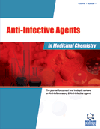- Home
- A-Z Publications
- Anti-Infective Agents in Medicinal Chemistry (Formerly Current Medicinal Chemistry - Anti-Infective Agents)
- Previous Issues
- Volume 7, Issue 2, 2008
Anti-Infective Agents in Medicinal Chemistry (Formerly Current Medicinal Chemistry - Anti-Infective Agents) - Volume 7, Issue 2, 2008
Volume 7, Issue 2, 2008
-
-
Potential of Selected Antioxidants for Influenza Chemotherapy
More LessAuthors: Noboru Uchide and Hiroo ToyodaThe human beings face the threat of a highly pathogenic avian influenza virus. The use of anti-influenza drugs is receiving much greater attention to playing an important role as a first-line defense against a new pandemic of influenza virus infection. However, influenza viruses resistant to currently available anti-influenza drugs, such as the M2 proton channel inhibitors and the neuraminidase inhibitors, are emerged freque Read More
-
-
-
Genetic Determinants of Tetracycline Resistance and their Effect on Tetracycline and Glycylcycline Antibiotics
More LessAuthors: C. H. Jones, E. Murphy and P. A. BradfordTetracycline class antibiotics have been a hallmark in terms of safety profile and spectrum of activity for nearly 60 years. Multiple resistance mechanisms have evolved to counter the tetracyclines with both of the chief mechanisms - efflux and ribosomal protection - widely spread in Gram-positive and Gram-negative organisms. The utility of the tetracyclines as growth promoters in domesticated food animals as well Read More
-
-
-
Celastrol and Terpenes as Anti-Infective Agents
More LessAuthors: Ngan H. Lee and John W. HoCelastrol is a quinone methide triterpene present in Celastraceae plants and is known to have multitude arrays of pharmacological activities. A common source of Celastrol is found in Tripterygium wilfordii Hook F which is an ivylike vine. Celastraceae has been used as a traditional medicine in China for hundreds of years. Celastrol has effectively been used in the treatment of autoimmune diseases, chronic inflammation, asth Read More
-
-
-
Development of Non-Nucleoside Reverse Transcriptase Inhibitors for Anti-HIV Therapy
More LessAuthors: Christer Sahlberg and Xiao-Xiong ZhouThe NNRTIs play an important role in the present therapy against HIV/AIDS. This review discusses the basic principles in the development of NNRTIs for HIV therapy. It also summarizes the NNRTIs in clinical use and the major series of NNRTIs in development phases. The authors intend to provide an overview of the NNRTI research and to elucidate some important factors in directing the future in the field such as genetic barrier, Q Read More
-
-
-
Fungicidal Activity of Azole Antifungal Agents
More LessAuthors: L. Majoros and G. KardosTreatment of invasive fungal infections with fungicidal antifungal agents is desirable in some clinical situations, particularly in the immunocompromised. However, there are a limited number of fungicidal drugs and most have undesirable side effects. Applicability of amphotericin B and its different lipid formulations is hampered by toxicity and the relatively low attainable serum concentration (not mo Read More
-
-
-
Multi-Functional Anti-HIV Agents Based on Amino Acid Sequences Present in Serpin C-Terminal Peptides
More LessThe observation that proteinases located at the surface of HIV-1 target cells were involved in viral infection led to the discovery of the anti-HIV-1 properties of serpin A1(α1-proteinase inhibitor, α1-antitrypsin). Antiviral activity could be explained by the capacity of serpin A1 to prevent binding of the HIV envelope glycoprotein to proteinases associated with host cell membranes. Surprisingly, serpin A1 inhibited as well HIV-1 repli Read More
-
-
-
Anti-Mycobacterial Activity of Quinolones. Triazoloquinolones a New Class of Potent Anti-Mycobacterial Agents
More LessAuthors: Antonio Carta, Sandra Piras, Michele Palomba, Daniela Jabes, Paola Molicotti and Stefania ZanettiA number of novel quinolone derivatives have been recently reported to posses in vitro and in vivo anti mycobacterial and DNA gyrase inhibition activities. It is known that mycobacteria expressing resistance to both isoniazid and rifampin (multi-drug resistant, MDR) is sensible to fluoroquinolones. Ciprofloxacin, oxfloxacin, moxifloxacin and levofloxacin are increasingly used for the treatment of tuberculosis, becaus Read More
-
Most Read This Month
Article
content/journals/aiamc
Journal
10
5
false
en


